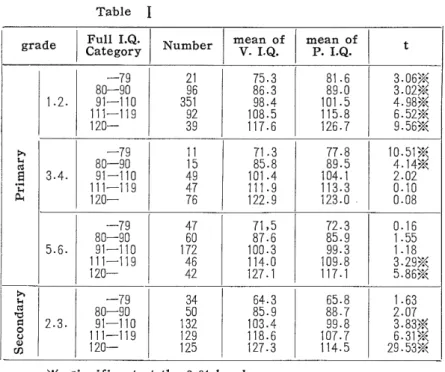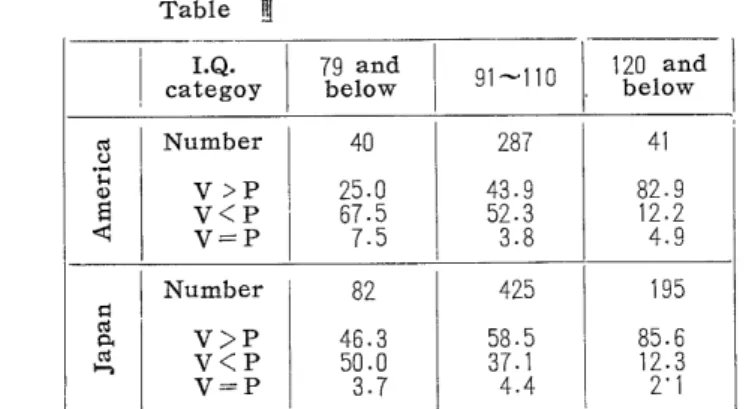An Approach to the Development of
Intelligence in Using of WISCHidehisa SAWA
Nagasaki University
Since the last revised edition of Binet test was published in 1911, many
‑tests have been modified for the purpose of ineasuring General intelligence Lin many countries. Since 1938, the different standpoint of Thurstone from
this viz. the exploration of mental structure by Group factors and the
・diagnostic tests which have followed have been becoming popular gradually under the stimulus of practical need, therapy.
Stanford‑Binet test, WAIS (Wechsler Adult Intelligence Scale) and WISC
<Wechsler Intelligence Scale for Children) are representative in U.S・A・(i)・e) It is well known in Japan that Japanese editions of Binet test and Stanford‑
Binet test have been published by J. Suzuki, R. Kubo and K. Tanaka. Japan‑
ese edition of WISC has also been published by S. Kodama and his group.
W‑‑B upon which WAIS is based has been revised by A. Yoda, but WAIS ]has not yet been edited in Japan.
WISC, including WAIS and W‑‑‑B, has characters both of Genera! factor theory of Spearman and of Group factor theory of Thurstone. So total I.Q can be measured by WISC as well as by Stanford‑Bint test, on the other hand, mental structure can be explained by the theory of Scatter・ (3)・(4) "
Wechsler's idea that he intended to explain both General and Group in‑
telligence at the same time by only one test was criticized by L. J. Cron‑
bach, as follows '̀it is not possible to eat one's c.ake and have it."(s) Nevertheless, it can be said that at present, WISC is the rnost repres‑
entative of all the tests that are intended to make the theory coincide with the Clinic.(s)
Our approach is to find out how Verbal I.Q and Performance I.Q may be changed with the progress of the grade from the Ist of primary schools to the 3rd of secondary schools and how the relation between Verbal I.Q and Performance I.Q may be changed as I.Q is high or low.
Two aspects of mental structure, that is, Verbal I.Q. and Performace I.Q.
‑85 ‑
have not been explained by Stanford‑Binet test, which is intended for measuring General intelligence. Of course, it will be a great problem toJ be solved in the future whether the aspects of mental structure are "two"
or more, but we do not take up this problem now. ' Procedure
Subjects were divided into 4 groups, primary School (1. 2), (3.4), (5.6) and secondary school (2.3>. Total members of each group were respectively 599, 198, 367 and 470. Next, we didided each group into 5 stages according to D. Wechsler‑‑‑under I.Q. 79, 8J‑‑90, 91‑‑110, 111‑‑119 and over 120. (7) Conspicuousness of the difference between mean Verbal I.Q. and mean Performance I.Q. of members in each stage has been criticized. TableI indicates it. Curves of Verbal I.Q. and Performance I.Q. of each stage are clearly shown in Fig. 1.
Conclusion
AsTableI and Fig.Ishow, Performance I.Q. of Ist and 2nd grades of the Fis. 1
Sradle
r. Q
s?o
IIO
too
90
8o
70
'x
Phima "y 5econ da lty
L2 3. 4. S. 6. 2. 3.
79 90 sto ll9 79 90 ttO IY9 79 9o ,to ll9 79 90 lto lt9
' s'o 4t :,t t5o ' s'o e, il, t5o ̀ s'o 6i i',, i5a ' s̀o g'i t:; ,So
t t ' t
l '
t x t i tt st tt'
g
t t
t
' t t t 'v
l l '
k
i ' t
V‑ 1.Q
P‑;Q
l l
t l sh
t
t
r
t l
f t t l 'f
t l t ' t t
t'
x
"
.
l t t l t t t
l ' ' '
'"‑ "' ‑‑ X‑ ‑'‑̀. .X t t
l t '
tg
ti i
t
r
t
)
. t 1 l
g ' '
' t
1 t t ' ' '
t t y t
t t t
t tx
‑ 86 ‑
Table I grade CategoryFull I.Q・
1.2.
‑‑‑79 80‑‑90 91‑‑‑11O 111‑1 19 1 20‑
Number
hts
H
'N‑
pt
Mk
vNq oo
coo 3.4.
21 96 351 92 39 ‑‑79
80‑90
91 ‑‑・11O
111‑‑119 1 20‑
5.6.
2.3.
‑‑79
80‑‑‑90 91‑‑‑‑11O
111‑‑119
1 20‑‑‑
‑‑‑79 80‑‑‑90 91‑‑‑11O 111‑1 19 1 20‑
11 15 49 47 76 47 60 172 46 42 34 50 132 129 125
mean of
V. I,Q.
75.3 86.3 98.4 108.5 117.6 71 .3
85.8 101.4 111.9 122.9 71,5 87.6 1OO.3 114.0 127.1
mean of
P. I.Q.
81.6 89.0 101.5 115.8 126.7 77.8 89.5 104.1 113.3 123.0 ,
72.3 85.9 99.3 109.8 117.1
64.3 85.9 103.4 118.6 127.3
65.8 88.7 99.8 107.7 114.5
t
3.06)*(
3.02X
4.98)*(
6.52X
9.56)*(
1O.51)*(
4.14)K 2.02 O.10 O.08 O.16 1.55 1.18 3.29)8(
5.86)8(
1.63 2.07 3.83×
6.31)*(
29.53)8(
)8( significant at the O.Ol level
primary school is always superior to Verbal I.Q. in all stages of intellig‑
ence. This relation between Performance I.Q. and Verbal I.Q. is the same with the case of inferior children of 3rd and 4th grades whose total I.Q. is under 90. In general, we can conclude that lower grades of the primary school are better in Performance which implies Visual Organization and Visual‑Motor CoOrdination than in Verbal that is Essential Verbal, Atten‑
tion and Concentration.(s)
Normal and superior children of the 3rdaand 4th grades, inferior and normal ones of the 5th and 6th grades of the primary school and inferior ones of the 2nd and 3rd grades of the secondary school are almost equal Table ll
LevelAge j Mean Differance (V‑I・Q.) minus P‑I.Q・)
5 6 7 8 9 10 11 12
13 14 15
All Ages
‑O.1 O.5
‑O.4‑O.2 o.o O.2 O.3‑O.8 O.5‑O.8 O.7 o.o
Standard Deviation of Difference
12.7 12.0 11.9 12.1 12.0 12.3 12.3 12.0 14.7 13.3 12.0 12.5 N==200 for each age
‑87‑
in both Verbal I.Q. and Performance I.Q. that is, differences are not signi‑
ficant. On the Contrary, superior children of 5,th and 6th grades of the primary school and normal and superior children of the 2nd and 3rd grades of the secondary school are higher in Verbal I.Q. than in Performance I.Q.
In other words, it may be said that superiority of intelligence of the up‑
per grades is predominated by Verbal.
Seashore's study seems to be inconsistent with ours. Table II shows the result brought about by the test to which/were pur 2200 male and female children from 5 years to 15 years old. As the table shows, there is little mean difference between Verbal I.Q. and Performance I.Q.(g)
This result is quite consistent with the theoretical research of the mak‑
ing of the test. If another experiment in U.S.A. support Seashores, it will be interesting to study the mental sttucture bf American school children.
For instance, it may be presumed from table II, III and Fig. II that the study of Wechsler's is nearly similar to Seashore's though it has no direct reference to this problem. Because, in the study of Wechsler's, 170 out of Fi9. ll
l.Q.
e/e
79 and
below 9/‑‑・(lo
l2odnd over
8o 7o
g
(P) 60
5o (P)XN
(v) NN
4o ,N
Nk
3o
NNN
(v) NN
2o NNN
lo ,
A'nierica{ : :. : J? pa n { e‑. ‑‑‑
‑ 88 ‑‑
Table va
l I.Q・
categoy
as
.9
8
<a
:N
a
hst
Number v>p v<p v=p Number v>p V<P
v‑‑p
79 and below
40 25.0 67.5 7.5
1 82 46.3 50.0 3.7
91 ‑‑11O
287 43.9 52.3 3.8 425 58.5 37.1 4.4
120 and , below
41
82.9 12.2 4.9 195 85.6 12.3 2'1
368 subjects are better in Verbal I.Q. than in Performance I.Q. and 182 subjects are quite the reverse.
But, the result we have met with is different from that with which Seashore met. The relation between Verbal I.Q. and Performance I.Q. in lower grades of the primary school is quite reverse to the relation betw. een Verbal I.Q. and Performance I.Q. in the upper grades of the primary school and all the grades of the secondary school.
In order to confirm this, we compared our study with Wechsler's. Table III and Fig. II indicates it,
In table III, V>P indicates the proportion of subjects whose Verbal I.Q.
is superior to Performance I.Q. and V<'P indicates that of subjects whose Verbal I.Q. is inferior to Performance I.Q. As the table $hows, in the case of inferior children, we can find a considerable difference between our study and the study in American‑it may be thought that Japanese inferior child‑
ren are drilled in Verbal more than American inferior children.
In other words, it is probably due to the difference of the educational system between the two countries. That is, in Japan, the social needs or the aspiration of parents and children to be superior in Verbal are very high, so there is an intense tendency to make every effort to teach child‑
ren Reading, writing, and Arithmentic.
But, in the case of superior children, there is a nearly complete coincidence
between our study and the American study and when we think of the similarity of curves in Fig. II, it can be under stood that the relation be‑
tween Verbal and Performance becomes reverse according to the superiority of intelligence (ib)
But we need to make any more representative sample and continue to study hereafter.
‑ ‑‑ 89‑
Summary
<1) In general, lower grades of the primary school are more excellent in Performance than in Verbal.
<2) Superiority of intelligence in the upper grades is predominated by Verbal.
<3) In the case of superior children, there is a nearly complete coincid‑
ence between American and Japanese children. But, in the case of inferior children, we can find a considerable difference between American and Japanese children.
References
1. Cronbach, L. J.:Essentials of Psychological Testing・ 1949, 101‑v139
2. Brown, M. H. and Bryan, G. E.:Sex differences in intelligence. J. clin. Psychol., 1655, 303‑‑304
3. Jastak, J.:Problems of Psychometric Scatter Analysis. Psychol. Bull., 1949, t77A‑197 4. Anastasi, A : Psychological Testing・ 1954, 329・・・333
5. Cronbach, L・ J・ : Ibid, 140‑v160
・6. Jastak, J. : An Item Analysis of the Wechsler‑Bellevue Test. J. Consult. Psychol.
1950, 88‑‑94
7. Wechsler, D. : The Measurement of adult intelligence・ 1944, 40.
:8. Cronbach, L・ J・ : Ibid, 148
9. Seashore, H. G. : Difference between Verbal and Performance I‑Q on the Wechsl‑
er intelligence Scale for children. J. Consult. Psychol・ 1951, 62Av67 10. Wechsler, D.:Ibid, 126
‑ 90 ‑‑‑

